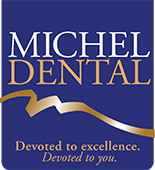
Dental Bridge – Topeka, KS
A Beautiful Way to Replace Lost Teeth
It doesn’t matter whether a gap is located at the front of your smile for all to see or near the back of the mouth; a missing tooth is always bad news for your oral health. Leaving the gap empty could lead to dental drift and other complications that end up severely damaging your grin over time. Whether you need to replace a single tooth or several teeth in a row, it’s best to have the space filled in as soon as possible – and the high-quality dental bridges in Topeka that Dr. Michel offers can do just that. Call us today to schedule a consultation to learn more about dental bridges and how they can be used to restore your brilliant, healthy smile.
What is a Dental Bridge?

A dental bridge is made up of a number of prosthetic teeth. A pair of crowns hold a row of false teeth called pontics between them. The crowns will rest on natural teeth while the pontics are what will actually fill in the gap. Our bridges are made out of gorgeous tooth-colored materials that can be shaded and customized to match the surrounding teeth so perfectly that most people won’t ever realize that your dazzling smile is anything less than natural. Your dental bridge will also be specially designed depending on how many teeth are missing. If you’ve only lost one tooth, there will only be a single pontic between the crowns. If two or more teeth are gone, multiple pontics will be used.
What are the Benefits of a Dental Bridge?

- Restore Your Appearance: The embarrassment of a missing tooth can make it hard to laugh and smile, but a dental bridge will help you get your confidence back.
- Improve Your Chewing and Speaking Ability: A full set of teeth is essential for enjoying a varied diet and speaking with complete clarity.
- Protect Your Smile: A full set of teeth is necessary to properly distribute the forces of your bite. A dental bridge helps ensure that your natural teeth don’t suffer excessive pressure that could cause them to wear down faster than normal. The restoration will also stop your natural teeth from drifting out of position.
- Easy Maintenance: Bridges are typically permanently anchored in the mouth, and as such they are brushed as if they were real teeth.
- Durability: Ceramic bridges can easily stand up to the pressures that real teeth have to endure on a daily basis. A well-cared for bridge can easily last around 10 to 15 years – maybe longer.
What is the Process for Getting a Dental Bridge?

During your first appointment, we’ll need to prepare the teeth that will support the bridge, also known as the abutment teeth. A small portion of enamel is removed so that a crown can be placed without making the teeth look unnaturally bulky. We’ll then take an impression of your teeth, which will be used by a dental lab to design the actual bridge. After a certain period of time, the bridge will be ready, and you’ll return to our office to have it placed.
Dental Bridge FAQs

Dental bridges have been used for generations to treat one or more lost teeth. Although they are tried and proven, it’s normal to have a few concerns before you’re ready to commit to the treatment. There’s no reason to worry because we’ll explain everything during your consultation. In the meantime, here are a few dental bridge FAQs in Topeka & Silver Lake to ease any apprehensions.
Why should I replace my lost teeth?
Whether you have lost a single tooth or more than one, it’s best to treat tooth loss quickly because it’s more than just an aesthetic problem. Your jawbone will slowly deteriorate with each tooth you lose. As much as 25% of your jaw’s density can be lost within just one year. Over time, your remaining teeth may not have the support they need to stay in place, increasing your risk of cavities, gum disease, and additional tooth loss. Replacing your missing teeth will preserve your natural smile and improve your oral health.
Are there different types of dental bridges?
You have more options than ever to treat tooth loss. Your dentist will examine your mouth and learn more about your goals before explaining each possible treatment, which can include:
- Traditional Fixed Bridge: An all-ceramic bridge is made to replace the crowns of your lost teeth. The dental bridge is held in place using crowns bonded to the adjacent teeth.
- Cantilever Bridges: If there is not a tooth on one side of the gap, a cantilever bridge can be supported with a single dental crown.
- Maryland Bridge: A metal framework allows it to attach to healthy teeth, so you don’t need dental crowns.
- Implant Bridge: 1-2 dental implants replicate the roots of your teeth to anchor your bridge to your jawbone.
Your dentist will help you make the best decision for your smile, lifestyle, and budget.
How much does a dental bridge cost?
There’s not a flat rate for a bridge because various factors affect the cost, such as the number of teeth being replaced, and the materials used. After examining your mouth, we will provide you with an estimate and explain the fees associated with your plan. We work with many leading dental insurances to use your benefits to offset the cost. Although every plan differs, your insurance can cover up to 80% of the cost after reaching your deductible. If there’s any remaining balance, we accept multiple payment options. Besides traditional payment methods, we also work with third-party financing. You can pay for your bridge using monthly installments to accommodate your budget.
How long will my bridge last?
A traditional bridge will last for 5 to 10 years before needing to be replaced, but it’s not unusual for them to last for much longer with the proper care, like maintaining your oral hygiene. An implant-supported bridge has the potential to last for a lifetime. You can promote the lifespan of your new smile by committing to your oral hygiene at home and visiting your dentist regularly.
Does Getting a Dental Bridge Hurt?
Before preparing to place your bridge, we will make sure that you don’t feel an ounce of pain by completely numbing the area of the mouth with a local anesthetic. After your teeth are prepared to support a bridge, it’s possible that they might feel slightly sensitive for the next few days. However, this discomfort should not last long and can normally be managed with over-the-counter pain relievers. If you’re receiving an implant bridge, you may experience mild soreness after your procedure, but this can be handled by following your aftercare instructions. If you ever experience outright pain due to your dental bridge, don’t hesitate to let our office know.
How Many Teeth Can a Dental Bridge Replace?
A dental bridge can replace one tooth or several teeth in a row, depending on your specific needs. Most commonly, bridges are used to replace one to three missing teeth, but in some cases, they can address even more, especially when supported by dental implant posts (this is what’s known as an implant bridge). The number of teeth a bridge can replace depends on the health and strength of the surrounding teeth; during your consultation, we’ll evaluate your oral health and the extent of your tooth loss before deciding on the best type of bridge to use.
Can I Remove My Dental Bridge?
Dental bridges are designed to be a permanent solution for missing teeth and aren’t meant to be taken out at home. They are securely placed and can only be removed by your dentist, typically if the bridge is damaged, needs replacing, or if there’s an issue with the supporting teeth. If you’re experiencing discomfort or think your bridge may be an issue, it’s important to schedule a visit with us right away, as trying to remove your bridge on your own may lead to damaged teeth or gums, or even harm to the bridge itself.
How Can I Take Care of My Dental Bridge?
To take care of your dental bridge, it’s important to maintain excellent oral hygiene—after all, it’s going to be a permanent addition to your smile moving forward. Brush at least twice a day and floss daily; these two practices are paramount. Regular dental checkups and professional cleanings are also key to keeping your bridge, as well as your overall oral health, in pristine shape. You should also avoid chewing on hard foods or using your teeth as tools to open packaging or hold objects, as these habits can cause damage to the bridge. Think of your bridge as an extension of your natural teeth, and keeping it in great shape shouldn’t be a challenge!